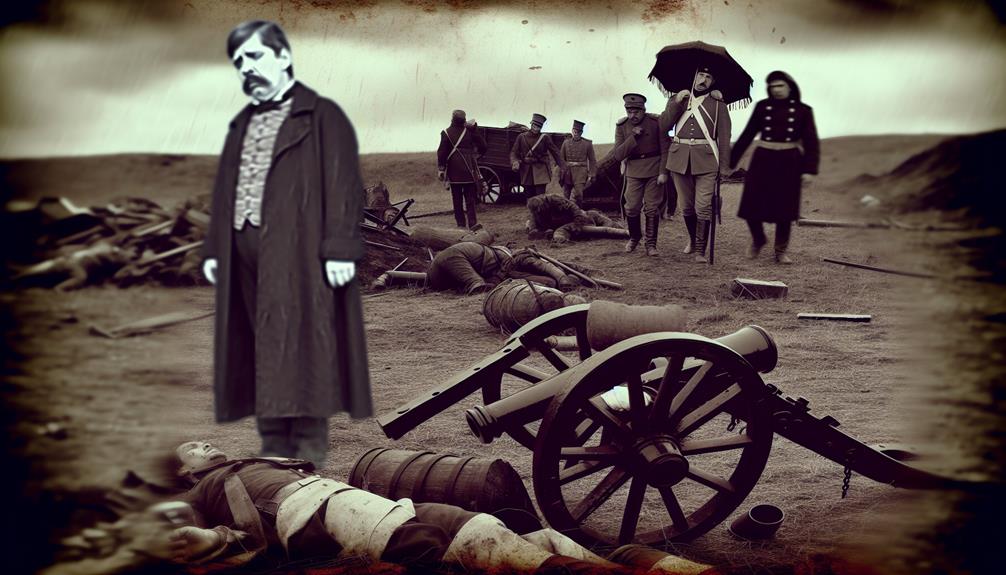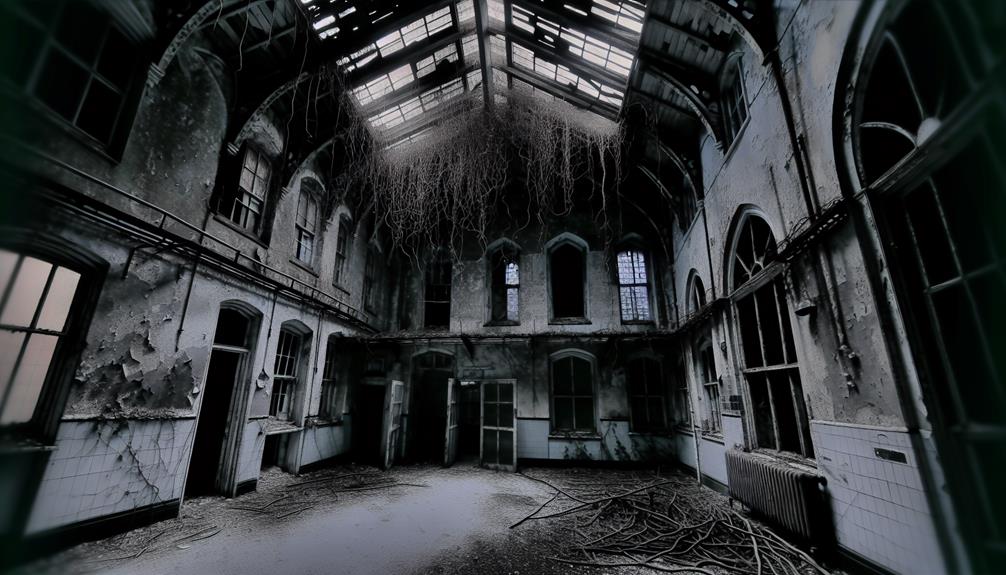The Battle of Waterloo stands as a pivotal moment in European history, marking the final defeat of Napoleon Bonaparte. As the two formidable forces clashed on the battlefield, a series of strategic decisions and unforeseen events propelled the conflict towards a decisive outcome. The intricate interplay of leadership, timing, and sheer determination on both sides culminated in a climax that reverberated far beyond the fields of battle. The aftermath of this monumental clash continues to intrigue historians and enthusiasts alike, offering a window into the complexities of power, ambition, and the unpredictable nature of warfare.
Key Takeaways
- Decisive defeat for Napoleon at Battle of Waterloo.
- Allied forces' strategic coordination pivotal.
- French defensive stance weakened.
- Napoleon's mistakes led to downfall.
- Surrender ceremony on July 15, 1815, marked end of Napoleon's military ambitions.
Napoleon's Last Stand
In the final battle of Waterloo, Napoleon Bonaparte faced a decisive defeat that marked the end of his military reign. Napoleon's leadership, characterized by his strategic brilliance and ability to inspire his troops, was tested on the battlefield against the allied forces led by the Duke of Wellington and Gebhard Leberecht von Blücher.
Napoleon's military tactics, which had previously brought him victories across Europe, faltered at Waterloo. His decision to delay the battle until the ground had dried after heavy rains proved to be a critical mistake. This delay allowed the Prussian army under Blücher to arrive, reinforcing the allied forces and tipping the scales against Napoleon.
Despite his renowned ability to adapt and innovate on the battlefield, Napoleon struggled to effectively coordinate his troops at Waterloo. His legendary speed and decisiveness were hampered by miscommunications and delays, ultimately leading to a fragmented and disjointed French attack.
Furthermore, Napoleon's failure to anticipate the defensive strategies employed by the Duke of Wellington, such as the use of infantry squares to withstand cavalry charges, further weakened his position. The combination of these factors, along with the exhaustion of his troops after a prolonged campaign, sealed Napoleon's fate on that fateful day.
The Duke of Wellington's Strategy
The Duke of Wellington's strategic approach at the Battle of Waterloo played a pivotal role in countering Napoleon Bonaparte's military tactics and securing a decisive victory for the allied forces. Wellington's tactics were characterized by meticulous planning, a deep understanding of the battlefield, and the effective utilization of his troops. His military genius shone through in various aspects of his strategy:
| Wellington's Tactics | Description |
|---|---|
| Defensive Posture | Wellington chose a strong defensive position on the high ground, utilizing the ridge at Mont St. Jean to his advantage. This allowed his forces to withstand Napoleon's attacks effectively. |
| Infantry Squares | To protect against the French cavalry charges, Wellington arranged his infantry in hollow squares, presenting a formidable defense against the enemy's mounted troops. |
| Timing of Counterattacks | Wellington's ability to time his counterattacks with precision, launching them at the opportune moment, disrupted Napoleon's advances and inflicted significant losses on the French forces. |
Wellington's ability to adapt his tactics to the changing dynamics of the battlefield and his strategic foresight were instrumental in the ultimate defeat of Napoleon at Waterloo. His calculated decisions and skilled command played a vital role in the allied victory, cementing his reputation as a brilliant military leader.
Prussian Reinforcements Arrive
Upon the arrival of Prussian reinforcements at the Battle of Waterloo, a pivotal shift in the military landscape unfolded, altering the course of the conflict. The Prussian forces, led by Field Marshal Gebhard Leberecht von Blücher, played a vital role in the outcome of the battle through their strategic tactics and effective military leadership.
Blücher's decision to march to the aid of the Duke of Wellington's army at Waterloo proved to be a decisive moment. The Prussian forces arrived in the nick of time, reinforcing the Allied troops and providing much-needed support in the face of Napoleon's advancing army. This coordinated effort between the British and Prussian forces demonstrated a high level of military coordination and communication, showcasing the effectiveness of their leadership.
The Prussian tactics employed during the Battle of Waterloo were instrumental in securing victory for the Allies. Their aggressive and relentless attacks on Napoleon's right flank not only diverted French forces away from Wellington's position but also inflicted heavy casualties on the French army. The Prussian forces, known for their disciplined formations and skilled cavalry units, effectively disrupted Napoleon's plans and contributed significantly to his ultimate defeat.
The Battle Begins
At the onset of the confrontation at Waterloo, the dynamics of the battlefield began to unfold as the opposing forces positioned themselves for the imminent clash. The French, under the command of Napoleon Bonaparte, initially took a defensive stance, with their troops forming a line along the gentle slopes of Mont-Saint-Jean. In contrast, the Allied forces, led by the Duke of Wellington, steadily advanced, positioning themselves strategically to exploit any weaknesses in the French defenses.
As the battle commenced, the French retreat became evident as they struggled to maintain their positions against the relentless Allied advance. The Allied forces, comprising British, Dutch, Belgian, and German troops, pushed forward with determination, gradually gaining ground and putting pressure on the French lines. Despite fierce resistance from the French army, the momentum seemed to shift in favor of the Allies as they pressed on, inching closer towards victory.
The initial stages of the battle saw a back-and-forth struggle, with both sides sustaining significant casualties. The French retreat, though tactical at times, was also a sign of the mounting pressure they faced from the advancing Allied forces. The Allied advance, characterized by coordinated movements and steadfast determination, set the stage for the pivotal moments that would soon follow in the unfolding conflict at Waterloo.
The Turning Point
Evident from the strategic shifts on the battlefield, what critical developments marked the turning point in the confrontation at Waterloo between Napoleon Bonaparte's French forces and the Allied troops led by the Duke of Wellington? The turning point at Waterloo can be attributed to a combination of Napoleon's downfall and strategic mistakes. Napoleon's decision to delay the start of the battle until midday allowed the Prussian army, under the command of Field Marshal Blücher, significant time to regroup and reinforce the Allied forces. This delay proved to be a pivotal error as it gave the Allies the opportunity to strengthen their position and coordinate their efforts effectively.
Furthermore, Napoleon's misjudgment of the battlefield terrain led to tactical errors that hindered the French army's movements. The muddy conditions caused by previous rain made it challenging for the French cavalry to maneuver effectively, weakening their impact on the battlefield. In contrast, the Allied troops were able to adapt to the terrain more efficiently, utilizing the high ground to their advantage.
Additionally, the breakdown in communication between Napoleon and Marshal Ney resulted in disjointed attacks that failed to break the Allied defense. Ney's decision to launch costly cavalry charges instead of coordinating with the infantry divisions further compounded the strategic mistakes made by the French forces. These critical developments ultimately shifted the momentum in favor of the Allies, marking the turning point that paved the way for Napoleon's ultimate defeat at Waterloo.
Allied Victory Secured
The culmination of strategic prowess and coordinated efforts solidified the Allied victory at Waterloo, sealing Napoleon Bonaparte's fate and marking a definitive end to his military ambitions. As the French retreat began, the Allied forces, comprising British, Dutch, Belgian, and Prussian troops, capitalized on their advantage, pushing back Napoleon's army and ultimately securing a decisive victory. The aftermath of the battle was not only a moment of relief for the Allies but also a cause for celebration.
To capture the essence of the Allied triumph, let us explore a symbolic representation through the following table:
| Emotion | Description |
|---|---|
| Triumph | Victory banners waving high, echoing cheers of success |
| Solidarity | Soldiers embracing, united in a shared sense of accomplishment |
| Gratitude | Communities expressing thanks for the protection and liberation |
| Hope | Bright horizons ahead, symbolizing a future free from tyranny |
The French retreat marked the beginning of the end for Napoleon's rule, while the Allied celebration resonated with a sense of unity and triumph. This momentous occasion not only brought an end to an era of conflict but also paved the way for a new dawn of peace and cooperation among nations.
Napoleon's Surrender
Napoleon's surrender at Waterloo marked a pivotal moment in European history, signifying the definitive downfall of his military ambitions and the end of his rule. The surrender ceremony that took place on July 15, 1815, was a moment of great significance as it brought an end to years of conflict and marked the beginning of a new era for Europe.
The negotiation process leading to Napoleon's surrender was complex and involved various key figures from both sides. After the decisive defeat at the Battle of Waterloo on June 18, Napoleon sought refuge with the intention of regrouping his forces. However, facing mounting pressure from the Allied forces led by the Duke of Wellington and the Prussian Marshal Blucher, Napoleon realized the futility of continuing the fight.
Negotiations for surrender began shortly after Napoleon's defeat, with the Allied powers demanding unconditional surrender. Despite initial resistance, Napoleon eventually acquiesced to the terms laid out by the Allies. The surrender ceremony itself was a solemn affair, symbolizing the end of an era dominated by Napoleon's military prowess.
Aftermath and Legacy
The repercussions of Napoleon Bonaparte's defeat at Waterloo reverberated across Europe, shaping the continent's political landscape for years to come. In France, the impact was profound. Napoleon's final defeat led to his second abdication and exile to the remote island of Saint Helena, effectively ending his ambitious reign and the Napoleonic era. The Congress of Vienna, convened in 1814 to redraw the map of Europe after Napoleon's initial defeat, now had to address the aftermath of Waterloo.
The victory of the Allied powers – Britain, Prussia, Russia, and Austria – over Napoleon marked a significant shift in the European balance of power. France, once the dominant force under Napoleon's rule, was now subjected to harsh penalties and territorial losses. The Bourbon monarchy was restored under Louis XVIII, seeking to stabilize the country after years of revolution and war.
The legacy of Waterloo extended beyond France, influencing European alliances and politics. The defeat of Napoleon guaranteed a period of relative peace in Europe, as the great powers sought to maintain a balance of power to prevent another dictator from rising. This led to the Concert of Europe, a system of regular diplomatic meetings to address issues and maintain stability. Waterloo's legacy also cemented the British Empire's status as a global superpower and propelled the rise of Prussia as a leading force in the unification of Germany.
The battle's aftermath reshaped the course of European history, leaving a lasting impact on the continent's future.
Frequently Asked Questions
How Did the Soldiers Communicate During the Battle?
During battles, soldiers communicated through various means such as signal flags and drum signals. Signal flags were used for visual communication over distances, conveying orders or information.
Drum signals were another method employed, with different drum beats representing specific commands or movements. These forms of communication were vital for coordinating troops, issuing orders, and maintaining cohesion on the battlefield, ensuring effective military operations.
What Role Did the Weather Play in the Outcome?
The weather conditions at Waterloo greatly impacted the outcome of the battle. Environmental factors such as heavy rainfall turned the battlefield into a muddy quagmire, affecting troop movements and hindering strategic maneuvers.
This forced both sides to adjust their tactics and formations, leading to unexpected outcomes. The role of the weather in shaping the battle's course highlights the importance of considering external elements in military planning and execution.
Were There Any Significant Medical Advances During This Time?
During the period surrounding the Battle of Waterloo, significant medical advances were being made in the field of battlefield medicine. Innovations such as the use of anesthesia, improved surgical techniques, and the development of prosthetics were emerging.
These advancements played a pivotal role in improving the survival rates of wounded soldiers and revolutionizing medical care on the battlefield. The era witnessed a shift towards more sophisticated and effective medical practices in combat situations.
How Were the Wounded Soldiers Cared for After the Battle?
How were the wounded soldiers cared for after the battle?
In the aftermath of conflicts, field hospitals played a vital role in providing immediate medical attention to the injured.
These facilities were equipped with essential medical supplies such as bandages, surgical tools, and medications.
Medical staff worked tirelessly to stabilize patients, perform surgeries, and administer treatments to make sure the wounded received the necessary care to promote healing and recovery.
What Impact Did the Battle of Waterloo Have on Local Civilians?
The Battle of Waterloo left a lasting impact on local civilians, shaping their experiences in the aftermath of the conflict. The community involvement in providing aid and support to those affected by the battle underscored the resilience and solidarity of the civilian population.
Civilian experiences were marked by the disruption of daily life, loss of loved ones, and challenges in rebuilding their communities. This event highlighted the interconnectedness between warfare and the local population's well-being.
Conclusion
To sum up, the Battle of Waterloo stands as a defining moment in European history, marking the end of Napoleon Bonaparte's military ambitions.
The defeat of Napoleon and the subsequent reshaping of European politics serve as a stark reminder of the impact of strategic errors and the importance of effective communication in warfare.
As seen in the case of Waterloo, even the most formidable leaders can face defeat when faced with superior planning and coordination by their adversaries.


